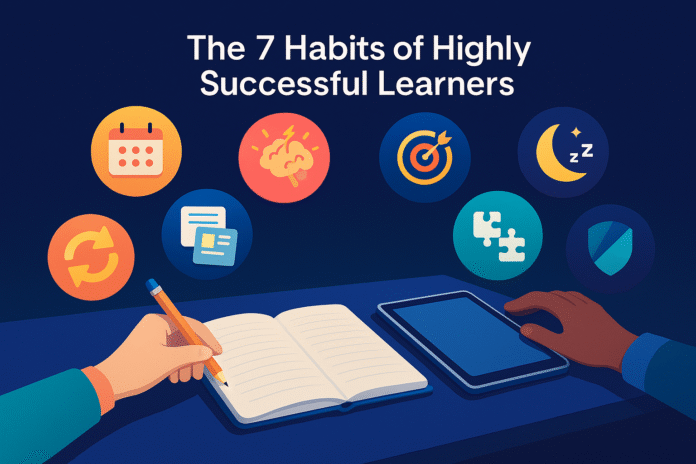If you’ve ever looked at top students, elite professionals, or fast-rising creators and wondered, “What are they doing differently?”, this guide is your blueprint. The 7 habits of highly successful learners are practical, repeatable behaviors anyone can adopt—whether you’re studying for a certification, ramping up a new job skill, or teaching yourself a creative craft. In the first few paragraphs you’ll see the core ideas, and then we’ll go deep with step-by-step instructions, sample mini-plans, and a 4-week roadmap you can start today. The focus throughout is on evidence-backed strategies: spacing, retrieval, deliberate practice, metacognition, interleaving, focus and energy management—applied in a realistic, human way.
Who this is for: self-learners, students, career-changers, creators, and professionals who want concrete methods to learn faster, retain longer, and perform better—without burning out.
What you’ll learn: how to set outcomes that actually guide action, how to study less but remember more, how to practice like a pro, how to measure progress intelligently, and how to turn learning into a rhythm you can keep.
Key takeaways
- Consistency beats intensity. Short, focused sessions done frequently outperform marathon cramming for long-term learning.
- Memory is built by retrieval. Testing yourself strengthens recall more reliably than re-reading.
- Time is a tool. Spacing and interleaving sessions produce deeper, more flexible knowledge than massed practice.
- Practice like a pro. Deliberate practice with quick feedback targets the exact skills that raise performance.
- Think about your thinking. Metacognition—planning, monitoring, and reflecting—prevents “illusions of learning.”
- Protect attention and energy. Focused blocks, quality sleep, and movement supercharge learning and creativity.
- Measure what matters. Simple metrics (recall rate, problem accuracy, streaks) keep you honest and motivated.
1) Define Clear Outcomes and a Simple Learning System
What it is and why it works
Successful learners start by making the target concrete and the process simple. Clear outcomes narrow your focus, and a lightweight system keeps you moving when motivation dips. You’re building a map (outcomes) and a daily road (system).
Core benefits: less procrastination, faster feedback, higher completion rates.
Requirements and low-cost alternatives
- Tools: notebook or notes app, calendar, timer.
- Nice-to-haves: Kanban board (Trello/Notion), simple spaced-repetition app, whiteboard.
- Low-cost alternative: a single sheet of paper for weekly plan + an index card for daily targets.
Step-by-step implementation
- Pick one enabling outcome for the next 30 days. Example: “Complete Units 1–4 of the SQL course and pass two practice exams at ≥80%.”
- Design your learning cadence: 5 days/week, 45–60 min per session, same time each day if possible.
- Build a week plan: list 3–5 “must-do” tasks that move you toward the outcome.
- Create daily targets: 1–3 tiny tasks per session (e.g., “review 30 flashcards,” “solve 5 query problems”).
- Close the loop: end each session with a 2-minute note—what moved, what’s next.
Beginner modifications and progressions
- If you’re overwhelmed: commit to 20-minute sessions and one tiny task per day.
- Progress when ready: increase session length to 60–90 minutes; add a weekly checkpoint (mock test or small project).
Frequency, duration, and metrics
- Frequency: 4–6 sessions/week.
- Duration: start at 30–45 minutes; adjust to 60 minutes as tolerance improves.
- Metrics: weekly completion rate (% of planned sessions done), outcome milestone dates, practice accuracy.
Safety, caveats, and common mistakes
- Mistake: goals that are vague (“get better at data”).
- Fix: phrase outcomes in observable terms (pass score, finished module, shipped artifact).
- Caveat: don’t over-engineer the system; simple beats fancy.
Sample mini-plan (2–3 steps)
- Write one 30-day outcome.
- Schedule five 45-minute sessions on your calendar this week.
- Choose tomorrow’s one tiny task and put it at the top of your to-do.
2) Use Retrieval Practice Every Day
What it is and why it works
Retrieval practice is the act of recalling information from memory rather than re-reading it. The effort of pulling an answer out—without looking—strengthens the memory and alerts you to gaps. It’s the most reliable way to make learning stick.
Core benefits: stronger long-term retention, better test performance, clearer sense of what you truly know.
Requirements and low-cost alternatives
- Tools: blank paper, flashcards (physical or digital), practice questions, a simple question log.
- Low-cost alternative: write questions on sticky notes; quiz yourself standing up without notes.
Step-by-step implementation
- Convert material into prompts. After each lesson, write 5–10 questions in your own words.
- Quiz before re-reading. Try to answer from memory first, then check notes.
- Use short daily drills. 10–20 minutes of questions or flashcards.
- Mix formats. Free recall (“Write what you remember”), cue-based (flashcards), and application (solve a problem).
- Track misses. Log items you failed to retrieve and repeat them later.
Beginner modifications and progressions
- If retrieval feels hard: allow a one-line hint.
- Progression: graduate to open-ended prompts and cumulative question banks spanning older topics.
Frequency, duration, and metrics
- Frequency: every study day.
- Duration: 10–30 minutes.
- Metrics: recall rate (% correct without peeking), time per question, reduction in “again” items.
Safety, caveats, and common mistakes
- Mistake: checking notes too early.
- Fix: commit to a guess; set a 10- to 20-second “struggle timer” before peeking.
- Caveat: retrieval is taxing. Pair with short breaks; don’t turn drills into marathons.
Sample mini-plan
- End today’s session by writing 8 questions.
- Tomorrow, answer them cold for 12 minutes.
- Mark anything missed and re-ask those items at the end.
3) Space and Spiral Your Study
What it is and why it works
Spacing means distributing practice over time instead of massing it in a single sitting. Spiraling means returning to prior topics at increasing intervals. Together they counter forgetting and strengthen memory consolidation.
Core benefits: longer retention, less re-learning, steady progress with less stress.
Requirements and low-cost alternatives
- Tools: calendar or spaced-repetition app (e.g., any flashcard app with scheduling).
- Low-cost alternative: a paper review schedule (Day 1, 3, 7, 14, 30).
Step-by-step implementation
- Set a default spacing ladder: review on the same day, then in 1, 3, 7, 14, 30 days.
- Tag your notes with “review due” dates.
- Batch tiny reviews. Spend 10–15 minutes cycling through due items before new learning.
- Spiral units. Start each new week with a 20-minute revisit of older topics.
Beginner modifications and progressions
- If you’re new: stick to Day 1–3–7 for the first month.
- Progression: personalize intervals based on difficulty; lengthen gaps for easy items.
Frequency, duration, and metrics
- Frequency: short reviews at the start of each session; longer spiral block weekly.
- Duration: 10–15 minutes per daily review; 30–45 minutes for weekly spiral.
- Metrics: due-item completion rate, stability (how long before the same item is “due” again), percentage retained after 30 days.
Safety, caveats, and common mistakes
- Mistake: cramming everything into one night; it feels productive but fades fast.
- Caveat: spacing may feel slower. Trust the curve—you’re trading short-term speed for long-term stability.
- Tip: keep reviews short; they are a warm-up, not the whole workout.
Sample mini-plan
- Create a simple 1–3–7–14–30 review table.
- At the end of today’s session, schedule three items for “Day 3” review.
- Next session: open with 10 minutes of due reviews, then proceed.
4) Practice Deliberately With Fast Feedback
What it is and why it works
Deliberate practice targets the exact sub-skills that drive performance. You isolate a skill, perform at the edge of your ability, get feedback quickly, and try again. This loop accelerates improvement in everything from coding to language to music.
Core benefits: faster skill growth, fewer plateaus, less time wasted on autopilot repetition.
Requirements and low-cost alternatives
- Tools: list of sub-skills, practice tasks with clear criteria, feedback source (mentor, rubric, model answers, automated tests).
- Low-cost alternative: produce a draft, compare to a high-quality example, mark the gap, and redo immediately.
Step-by-step implementation
- Break the skill down. For SQL: joins, filtering, window functions, query optimization.
- Set a drill with a clear bar. Example: “Solve 5 window-function prompts with ≤10% error in 25 minutes.”
- Get feedback fast. Use unit tests, solution notes, or peer review.
- Repeat cycles. Short loops (10–20 minutes) of attempt → feedback → adjust.
- Collect errors. Keep a “bug list” of recurring mistakes and design a micro-drill for each.
Beginner modifications and progressions
- If you lack a coach: use rubrics and exemplars; ask one targeted question in a forum.
- Progression: increase complexity, reduce guidance, and train under realistic constraints (time limit, no hints).
Frequency, duration, and metrics
- Frequency: 2–4 sessions/week focused on drills.
- Duration: 30–90 minutes per session.
- Metrics: accuracy, speed to criterion, error-type frequency, time-to-feedback.
Safety, caveats, and common mistakes
- Mistake: mindless repetition.
- Fix: define “what good looks like” before you start.
- Caveat: deliberate practice is mentally demanding. Insert short breaks; stop when quality drops.
Sample mini-plan
- Choose one sub-skill and write a criterion (e.g., “≥4/5 correct”).
- Run two 15-minute attempt→feedback loops.
- Log the top two errors and design a 10-minute micro-drill for each.
5) Think About Your Thinking (Metacognition & Reflection)
What it is and why it works
Metacognition is the habit of planning your approach, monitoring your understanding while you work, and reflecting after you’re done. It catches the “illusion of competence” early and keeps your study sessions honest and efficient.
Core benefits: better strategy selection, fewer blind spots, higher transfer to real tasks.
Requirements and low-cost alternatives
- Tools: a learning journal, simple checklists, self-explanation prompts (“Why does this step work?”).
- Low-cost alternative: at the end of each session, answer three reflection questions on a sticky note.
Step-by-step implementation
- Plan: before you start, write today’s target and how you’ll know you hit it.
- Monitor: during work, pause every 15–20 minutes and ask, “Can I explain this without notes?”
- Reflect: after, write 2–3 sentences—what worked, what didn’t, what to try next.
- Self-explain: pick one tricky idea and explain it to your future self in plain language.
Beginner modifications and progressions
- If this feels like extra work: keep it to 90 seconds pre- and post-session.
- Progression: add “exam wrappers” after tests (analyze errors, time usage, mismatches between feeling and result).
Frequency, duration, and metrics
- Frequency: every session.
- Duration: 2–5 minutes planning; 2–3 short pauses; 3–5 minutes reflection.
- Metrics: prediction accuracy (how your “I’ll get 80%” matches reality), number of strategies tried, decrease in repeated errors.
Safety, caveats, and common mistakes
- Mistake: journaling without changing behavior.
- Fix: end reflections with one concrete tweak for the next session.
- Caveat: perfectionism can creep in. Metacognition should guide action, not punish you.
Sample mini-plan
- Write today’s target and “definition of done.”
- Schedule two 30-second mid-session checks.
- Close with three sentences: what worked, what to change, next action.
6) Mix It Up: Interleaving and Variability
What it is and why it works
Interleaving means practicing different problem types or topics in a mixed order, not in blocks. Variability exposes you to different contexts and cues. This forces you to choose a strategy, not just apply the one you just rehearsed, which improves flexible problem solving.
Core benefits: better transfer, stronger discrimination between concepts, sturdier performance under pressure.
Requirements and low-cost alternatives
- Tools: a bank of mixed problems or tasks; index cards labeled by type; a randomizer (shuffle).
- Low-cost alternative: after two problems of one type, switch to a different type and come back.
Step-by-step implementation
- Identify 3–4 problem types you tend to block together.
- Create a mixed set with a balanced number from each type.
- Rotate deliberately: A → B → C → A → C → B.
- After each item, name the clue that told you which method to use.
Beginner modifications and progressions
- If it feels too chaotic: start with short mini-blocks (two of each) before mixing.
- Progression: remove category labels so you must classify problems on the fly.
Frequency, duration, and metrics
- Frequency: 2–3 interleaved sessions/week.
- Duration: 30–60 minutes.
- Metrics: accuracy by type, time to identify problem type, drop in “wrong method” errors.
Safety, caveats, and common mistakes
- Mistake: abandoning a topic too soon; you need some baseline familiarity before mixing.
- Caveat: interleaving feels harder and sometimes less satisfying—this is normal and desirable.
Sample mini-plan
- List three problem types you confuse.
- Build a 15-item mixed set.
- After solving each, write the clue that triggered your method choice.
7) Protect Focus, Energy, and Sleep
What it is and why it works
Attention is the gateway to learning, and sleep is the lab where the brain stabilizes and reorganizes memories. Managing your environment, your breaks, and your rest multiplies the gains from every other habit.
Core benefits: higher quality sessions, faster insight, better long-term recall.
Requirements and low-cost alternatives
- Tools: timer, distraction blockers, earplugs or headphones, a simple wind-down routine at night.
- Low-cost alternative: airplane mode + a handwritten “do not disturb” note.
Step-by-step implementation
- Carve out focus blocks. 25–50 minutes of undivided attention, then a short break.
- Single-task. Close everything unrelated; keep a capture sheet for stray thoughts.
- Move and hydrate. Stand up between blocks; short walks reset attention.
- Sleep for consolidation. Aim for a consistent bedtime and wake time; avoid heavy study the last 30 minutes before sleep—review lightly or quiz.
Beginner modifications and progressions
- If you’re easily distracted: start with 15–20-minute blocks and add 5 minutes each week.
- Progression: stack two or three 50-minute blocks for deep work on complex tasks.
Frequency, duration, and metrics
- Frequency: daily.
- Duration: 1–3 focus blocks per day.
- Metrics: number of distraction-free blocks, average block length, sleep regularity, perceived energy (1–5 scale).
Safety, caveats, and common mistakes
- Mistake: equating longer hours with more learning.
- Fix: prioritize quality blocks; end while you can still do good work.
- Caveat: chronic sleep restriction erodes learning and attention; catch-up sleep doesn’t fully repair it.
Sample mini-plan
- Schedule two 30-minute focus blocks tomorrow.
- Put your phone in another room and close all tabs but one.
- End the day with a light 10-minute review before bed.
Quick-Start Checklist
- One 30-day outcome written in observable terms.
- Five sessions scheduled this week (30–60 minutes).
- A tiny daily retrieval drill (10–20 minutes).
- A simple spacing ladder (1–3–7–14–30) taped to your desk.
- One deliberate practice drill defined with a clear criterion.
- A reflection template with three questions.
- A plan for two distraction-free focus blocks tomorrow.
Troubleshooting & Common Pitfalls
- “I keep re-reading but nothing sticks.” Replace re-reading with retrieval. Write questions and answer them cold.
- “I understand in the moment but forget a week later.” Add spacing. Short, frequent reviews beat big, rare ones.
- “Practice feels busy but I’m not improving.” Switch to deliberate practice: set a criterion, get feedback fast, and fix one error type at a time.
- “I can’t tell which method to use on problems.” Interleave. Mix types and name the clue that triggered your choice.
- “I don’t know if I’m learning.” Track recall rate, accuracy, and time-to-solve; review your reflection notes weekly.
- “I run out of steam.” Shorten sessions, insert brief walks, and improve sleep consistency.
- “I’m overwhelmed by tools.” Use paper: a notebook, index cards, and a timer are enough.
- “I’m afraid of getting questions wrong.” Errors are data. Retrieval failures tell you exactly what to study next.
How to Measure Progress (Simple, Honest Metrics)
- Consistency: sessions completed / sessions planned (weekly %).
- Retention: retrieval accuracy without notes after 7+ days.
- Transfer: accuracy and speed on mixed, unseen problems.
- Skill growth: time-to-criterion in deliberate drills; number of repetitions needed to hit the bar.
- Metacognition: prediction-vs-result gap (are your confidence estimates getting closer?).
- Focus quality: number of truly distraction-free blocks.
- Energy & recovery: sleep regularity; subjective energy (1–5) at session start.
Log these in a simple weekly dashboard. Celebrate streaks, not just outcomes.
A 4-Week Starter Plan (Roadmap)
Goal: adopt all seven habits at a sustainable pace while making visible progress on one concrete outcome.
Week 1 — Foundation & Rhythm
- Outcome: define a 30-day learning outcome and schedule your week.
- Habits: start focus blocks, daily retrieval (10–15 minutes), and end-of-session reflections.
- Plan: five sessions × 40 minutes. Open each with 10 minutes of retrieval; end with 3-minute reflection.
- Checkpoint: by Friday, complete two small deliverables (e.g., a mini-quiz and one short exercise set).
Week 2 — Add Spacing & Interleaving
- Outcome: finish Unit 1 tasks and begin Unit 2.
- Habits: implement a 1–3–7 spacing ladder; create a 12-item mixed problem set.
- Plan: five sessions × 50 minutes. Start with due reviews; two sessions include the mixed set.
- Checkpoint: compare retrieval accuracy on new vs. 7-day-old items; note improvements and gaps.
Week 3 — Deliberate Practice & Feedback
- Outcome: isolate two sub-skills; set criteria and run short attempt→feedback loops.
- Habits: add 2 dedicated deliberate-practice sessions (60–75 minutes).
- Plan: four standard sessions + two drill sessions.
- Checkpoint: track time-to-criterion and top errors; design a 10-minute micro-drill for each error.
Week 4 — Integrate, Simulate, and Review
- Outcome: simulate an evaluation relevant to your goal (mock exam, code challenge, mini recital).
- Habits: sustain spacing, retrieval, focus, and reflections.
- Plan: two normal study sessions; one interleaving session; one full simulation under realistic conditions; one review session to analyze results and adjust your plan for the next month.
- Checkpoint: write a brief after-action report—what to keep, what to change, and your next 30-day outcome.
FAQs
1) How many hours should I study each day?
Start with 45–60 minutes and build from there. Two quality blocks often beat three or four distracted ones. Your weekly consistency matters more than a single day’s duration.
2) Is taking notes still useful if retrieval is so powerful?
Yes—but use notes to create prompts, examples, and summaries you’ll later test yourself on. Notes are raw material; retrieval is the builder.
3) What if I don’t have time for spacing?
Spacing requires tiny doses, not large chunks. Even 10 minutes of review on Days 1–3–7 produces better retention than one long cram session.
4) How do I apply these habits to skills, not just facts?
Use deliberate practice: break the skill into sub-skills, define a criterion, get quick feedback, and run short loops. Mix in retrieval by recalling steps or rules before performing them.
5) I feel worse when I interleave. Is that normal?
Yes. Interleaving feels harder because you’re constantly choosing strategies. The effort is a sign you’re building flexible knowledge—not a problem to avoid.
6) What’s the best way to stay motivated?
Make the next step tiny and visible. Track streaks, celebrate small wins, and keep your environment “friction-free” (materials ready, timer handy, no notifications).
7) Should I use apps or go analog?
Use whatever reduces friction. A paper deck of 100 flashcards and a wall calendar can outperform the fanciest app if you use them consistently.
8) How do I know if I’m actually improving?
Check objective metrics weekly: retrieval accuracy on 7-day-old items, problem accuracy and speed on mixed sets, and time-to-criterion in drills. Compare this week to last week.
9) What if I keep making the same mistake?
Promote it to a first-class target. Write a micro-drill that practices only that error pattern, set a criterion, and loop until it disappears.
10) Can I study effectively if my schedule changes daily?
Yes. Anchor learning to an existing routine (after breakfast, before lunch, after work) and use shorter blocks. Protect at least one 30-minute focus window per day.
11) Do breaks ruin momentum?
Good breaks protect quality. Stand up, move, hydrate, and avoid screens for a few minutes. You’ll return sharper and finish faster.
12) How does sleep fit into all this?
Sleep stabilizes and integrates memories. Keep a consistent schedule, use light review in the evening, and avoid late-night cramming whenever possible.
Conclusion
Learning is not a talent you either have or don’t. It’s a stack of habits you can build—one short, consistent block at a time. Start with a clear 30-day outcome, add daily retrieval and spacing, mix your practice, work deliberately with feedback, reflect honestly, and protect your attention and sleep. The result isn’t just better grades or faster promotions; it’s a sense of control over your growth that compounds for life.
Copy-ready CTA: Pick one habit from this guide, schedule a 45-minute block for tomorrow, and do the first tiny step.
References
- Improving Students’ Learning With Effective Learning Techniques: Promising Directions From Cognitive and Educational Psychology — Psychological Science in the Public Interest (2013). https://journals.sagepub.com/doi/10.1177/1529100612453266
- Distributed Practice in Verbal Recall Tasks: A Review and Quantitative Synthesis — Psychological Bulletin (2006). https://doi.org/10.1037/0033-2909.132.3.354
- Test-Enhanced Learning: Taking Memory Tests Improves Long-Term Retention — Psychological Science (2006). https://journals.sagepub.com/doi/10.1111/j.1467-9280.2006.01693.x
- The Effects of Interleaved Practice — Memory & Cognition (2007). https://link.springer.com/article/10.3758/BF03194304
- The Role of Deliberate Practice in the Acquisition of Expert Performance — Psychological Review (1993). https://doi.org/10.1037/0033-295X.100.3.363
- The Self-Explanation Effect — Cognitive Science (multiple studies overview). Example entry: Cognitive Science (1994). https://www.sciencedirect.com/science/article/abs/pii/S0364021394710415
- Multimedia Learning Principles and Dual Coding (overview chapter) — Cambridge University Press (2009). https://doi.org/10.1017/CBO9780511811678




































